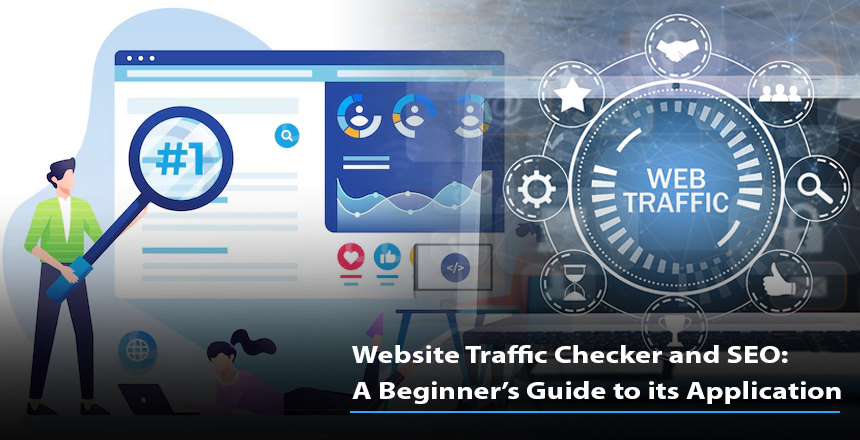If you haven’t been running a website or blog for long, you probably know about website traffic and SEO (Search Engine Optimization). These work together to help you build your online presence.
Yet, specific ways in which these subjects link together are not clear. How can you use website traffic checker tools to benefit your SEO?
We’ll make everything easy to understand in this guide.
How Do I Understand Website Traffic?
The number of people visiting your website each day is what we call traffic. You should think of it as the number of people who come into a store. Every time more people visit your website, your chances of achieving your goals go up — whether you want to sell products, have people register or get readers for your articles.
- There is more than one type of traffic.
- Those who explore your internet site through search engines like Google are known as organic visitors.
- People who enter your URL into their browser are considered direct traffic.
- When you receive referral traffic, visitors have come to your website by clicking a link they found somewhere else.
- This type refers to visitors who reach your website through Facebook, Twitter, Instagram and other social sites.
What Does SEO Mean and Why Does It?
SEO is the practice of using techniques to help your website appear near the top of internet search pages. If your website is focused on local coffee shops, it can appear under “best coffee shops in Delhi” and get visitors.
Getting traffic that comes from search engines for free and is aimed at your product, is usually the best kind.
How Does Website Traffic Checker Support SEO?
This is now where everything connects. A website traffic checker lets you monitor and learn about website traffic.
- How often people are visiting your website
- Data on the source of incoming traffic
- What pages are having the highest success
- Keyword research tells you which search phrases are bringing visitors to your website.
- The kind of interactions people are having on your site
- Using this data will help you boost your SEO. Let’s see what they did to accomplish this.
1. Discover the Effective and Ineffective Aspects
Suppose you created five blog posts in the previous month. A traffic checker tells you which blog post was the most visited. You can tell by the view count that something may have worked in your favor, for example, your topic interested people more or you chose good keywords.
Because of this, you know which kind of content to publish.
2. Identify the Places Where People Are Finding You
Do most visitors to your website find you through Google? Are you noticed by people via Facebook, Instagram or LinkedIn? A traffic tool will present the data in this way.
If your page doesn’t get many searches, it likely needs better SEO. Perhaps you haven’t chosen solid keywords or your site has yet to appear in search results.
If your search traffic increases, it’s very good news. You’re heading in the right direction.
3. Monitor how keywords are doing.
Some resources allow you to find out which keywords visitors are searching for to reach your site. This makes a big difference for your SEO.
When you see “easy vegan recipes” works well, you might want to create more similar ideas such as “vegan snacks you can make quickly” or “simple vegan breakfast recipes.”
4. Bounce rate and time devoted to the site are metrics you should monitor.
Bounce rate is the number of people who visit your site and immediately go away. If your bounce rate is high, your web pages may not offer help or visitors might find your site too slow.
The time on site shows you how long visitors stay at your site. Shorter sessions won’t give the best results. The longer people stay on your page, the better search engines see you and may give you a higher ranking.
5. Keep an eye on your Competitors
Certain tools allow you to examine website traffic on other domains, not only for your website. You can see how other businesses are doing in this industry with market share.
Many schools let you study:
- Which subjects create the most visitors for their website
- What terms they have appeared high in on search results
- The sources of their backlinks
- After that, you can use what you learned to boost your own approach.
- Use these simple and free tools if you’re new to SEO.
Here are some simple resources you can try for understanding traffic and SEO:
- Google Analytics – Helps you examine your website’s activity in great detail.
- Google Search Console provides you with your website’s search rankings and keywords.
- Ubersuggest is a tool that supplies you with keyword ideas, estimates of visitors and SEO advice.
- SimilarWeb allows you to see the traffic any website receives (very useful for analyzing resources).
- SEMrush (Free Version) supplies some valuable SEO and traffic details.
Final Suggestions for Startponents
Make it easy for yourself – Begin with simple data that is easy to collect. Pay attention to how your website is getting visitors, which pages are most viewed and what keywords are bringing them in.
Keep working at SEO as it usually takes some months to see results. Keep adding helpful content and keep an eye on how much traffic you are getting.
Use what the data tells you to choose your next course of action. If your blog post resonates, write additional ones in the same way. If your traffic numbers decrease, figure out the reason.
Wrapping Up
Going over the numbers alone isn’t the only reason to use a website traffic checker. It means getting to know who your audience is and acting strategically to develop your website.
A mix of SEO and content management gives you the opportunity to increase website traffic, better your content and achieve your online goals.
If you are a blogger, run a small business or just beginning online, spend some time discovering your traffic data — it can really help your site succeed.








